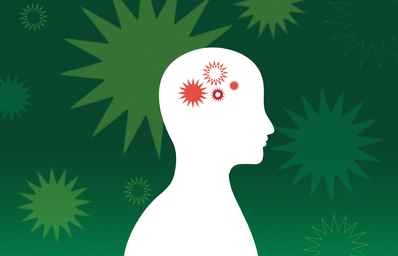This is a sponsored feature. All opinions are 100% from Her Campus.
No matter if it’s from a long day of classes, an accidental caffeine withdrawal, or an everyday occurrence that shows up at the same time like clockwork – the throbbing, knocking, panging aches from a migraine can really turn a great day into a lousy one.
If you’re anything like Los Angeles-based natural makeup artist, Jamie Greenberg — a fellow migraine-sufferer — or the rest of the 39 million Americans that suffer from migraine attacks, you’ve probably participated in all of the Google searching and self-diagnosing, but are still wondering why you get them, what your triggers are and how the heck you can fix the problem.
Have no fear, though! Because Jamie Greenberg is partnering with Excedrin to help close the Migraine Diagnosis Gap – which is the six-year average it takes between the first onset of migraine and formal diagnosis – and we were able to sit down with her to talk about all things migraine, and hear her thoughts on the topic! We also chatted with Dr. Elizabeth Seng, a clinical psychologist, and Excedrin Head Pain expert who specializes in the study and treatment of migraine, chronic pain, and other health problems influenced by stress, where she shared some incredible insights for ways to live your best life, even when you get a migraine.
Check out what both Jamie and Dr. Seng had to say about being diagnosed, what triggers a migraine, the tips they had for balancing a full course load even when you struggle with them, and so much more!
The first step to facing a migraine head-on is getting diagnosed.
Jamie Greenberg: ”I experienced my first migraine in high school, but I wasn’t officially diagnosed until my early 20s. At first, the head pain was intermittent and I didn’t know what was causing it. When my symptoms felt more serious than just a regular headache, my mom took me to the doctor, and that was when I was formally diagnosed. Although I was so relieved to finally know what was causing my pain, it was many years of uncertainty, and at the time it was really scary (I truly thought I was dying!). It turns out, that’s not uncommon. In fact, migraine sufferers wait on average up to six years from the time they first experience symptoms, which is typically around age 16, before getting a formal diagnosis.”
Dr. Seng: “Migraine can be diagnosed by several types of doctors, most commonly primary care or neurology. When you are first diagnosed with migraine, the doctor may want to see you every month or two to make sure your symptoms are responding to the recommended treatments. Once you are stable on a treatment regimen, you may see your physician every 3-6 months.”
Identifying the issues can be intimidating, but is extremely important.
Dr. Seng: “There is a large genetic component to migraine, which means that migraine often runs in families. However, genetics are not the only reason someone has a migraine. When someone has certain genes associated with migraine, they may be predisposed to experience migraine when they also experience environmental triggers like high stress, poor sleep, or hormonal changes – like “menstrual migraine”, which are real and happen around your period.
[Additionally], early in a migraine attack, before the pain starts, your brain has already begun experiencing the changes of a migraine attack. Some of those early symptoms are hypersensitivity to smell, sound, and light. So certain pungent scents may trigger migraine attacks.
Other common triggers include stress, skipping meals, dehydration, eating certain foods, caffeine and alcohol use and withdrawal, poor quality sleep, and weather changes. However, migraine attacks are very personal, and the triggers that may affect one sufferer may not affect another. Paying attention to the potential triggers you have control of can help improve your migraine management.”
Jamie: “Over the years, I learned that it’s really important to be aware of my migraine triggers in order to prevent an attack. For me, that means doing my best to make healthy food choices, stay hydrated, sleep well and manage stress with meditation. Learning your triggers can be a hard process to navigate – I had to get detailed and keep notes on everything to find patterns. If I do feel a migraine coming on, I make sure to take Excedrin to help stop my migraine symptoms.”
You don’t have to struggle or suffer solo.
Jamie: “The tricky thing about having a migraine is that the pain is invisible, so oftentimes people don’t know what you’re going through unless you tell them. It can be hard to let others know you need to take the time to focus on your health or deal with migraine pain you are experiencing, but it’s important to prioritize your health. If you’re ever in a situation where you are experiencing a physical or mental health symptom that makes you confused or scared, don’t suffer in silence.
My advice is to [also tell your teacher or boss] that you struggle with migraine – just be honest with them! It really helps to talk to your friends, family, and coworkers so they better understand what it’s like to get a migraine attack, and how they can help you in the moment.
I always used to worry about how my migraine would disrupt my work schedule and that clients would think I’m unreliable, so I would stay silent about my migraine pain (stupid stigma!). Early into my career, I learned that most of my clients were supportive and sympathetic to my migraine pain and symptoms once I opened up about what I was experiencing. After opening up to them, many of my clients shared that they were migraine sufferers too! It’s a very real condition and people often surprise you with their reaction.”
Dr. Seng: “Acknowledging a sufferer’s pain goes a long way. Especially if they went years without a proper diagnosis! Saying “I am sorry you are having migraine, that must be hard,” can be a validating statement to hear. Avoid comparing pain, or other types of headache, to migraine and instead offer empathy and understanding, as invisible illnesses like chronic pain conditions can be very isolating. Just do your best to be a good friend by being understanding of their painful experience.”
Manage your migraine, and keep it in control this semester!
Jamie: “Excedrin is my go-to for migraine control! I always make sure to keep a bottle in my makeup kit for when I feel a migraine coming on, especially Excedrin Migraine, because it can help provide fast migraine relief. This helps to relieve my symptoms so I can get back to work. And even more importantly, the best way to combat these headaches is by being prepared by taking notice of your triggers and finding what works to prevent them — which usually includes good sleep, stress management.
I also encourage everyone to find a way that works best for them to reduce stress and consider managing your migraine as a form of self-care. For me, being stressed out or even being around certain people that cause me stress can lead to a migraine attack. Stress can manifest itself in weird ways so I try to keep my stress levels low by practicing mindfulness meditation a couple of times a week.”
Dr. Seng: “We can help prevent migraine with medication, injections, or devices that you use routinely to reduce how often you experience migraine attacks. Lifestyle changes can also reduce migraine attack frequency. The most common triggers are related to inconsistent schedules (which can be very common for college students, with late nights studying).
When you have a migraine, it is important to stay consistent with your lifestyle and schedule: when you rise from bed and go to bed, when you eat, and when you drink water. Be prepared in advance, and consider carrying your own snacks and water bottle to maintain a consistent schedule. Try to go to sleep and rise at the same time every day (even if it’s the weekend), and carry your acute migraine medication like Excedrin Migraine with you in case you feel a migraine coming on.
To sum it up: Take care of yourself: protect your sleep, eat routine and healthy meals, stay hydrated, and don’t overdo it on caffeine and alcohol. Sometimes it’s helpful to take breaks during the day and practice deep breathing or muscle stretches.”
So, now that you’ve learned about how to get a migraine diagnosed, what the triggers are, how Excedrin Migraine can help provide fast migraine relief, and just about everything else there is to know about the topic, you can move forward with your semester confidently and without confusion or pain.
You can also join the Excedrin #MYgraine movement, which encourages sufferers to share their own experience with migraines through visual expression and ignite a much-needed conversation to help close the ‘Migraine Diagnosis Gap.’ Do you want to share your #MYgraine expressions to help others?! Then head to TikTok and Instagram and help raise awareness and make an impact for first-time migraine sufferers, so no one has to suffer alone.”


